Category: Recommended Reading
Affinities – in the eye of the beholder
Anil Gomes in The Guardian:
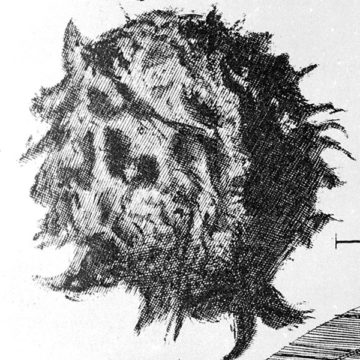 Why do some things combine and others separate? Add nitric acid to gold, and nothing happens. Pour on aqua regia, a mixture of nitric and hydrochloric acids, and the gold dissolves. The chemical doctrine of affinity emerged as a way to explain these reactions. In his 1809 novel Elective Affinities, Johann Wolfgang Goethe applied the idea to human relationships. Charlotte and Edward may form a stable union but if Edward has an affinity with young Ottilie – ah, well, then all bets are off.
Why do some things combine and others separate? Add nitric acid to gold, and nothing happens. Pour on aqua regia, a mixture of nitric and hydrochloric acids, and the gold dissolves. The chemical doctrine of affinity emerged as a way to explain these reactions. In his 1809 novel Elective Affinities, Johann Wolfgang Goethe applied the idea to human relationships. Charlotte and Edward may form a stable union but if Edward has an affinity with young Ottilie – ah, well, then all bets are off.
What is an affinity? A little like a crush, I suppose, at least at the beginning. And sometimes just as fleeting. But sometimes more stable, more serious, and more revealing of our ways of engaging with things. Brian Dillon’s writings have always been marked by affinities – for artworks, for writers, even for particular sentences. In this work he turns his attention to the notion of affinity itself, through an examination of images that have drawn his gaze.
We start with a picture from Robert Hooke’s 1665 work Micrographia: a full stop as seen under a microscope, the tiny circle revealed in magnification to be “disfigured, ragged, deformed”. We pass through Julia Margaret Cameron’s portrait of her niece, pictures of seahorses from a documentary, a scientific drawing of a migraine aura from 1870. There are abstract patterns captured in the ruins of Hiroshima, dadaist collages, a still from the BBC film production of Samuel Beckett’s Not I – our attention guided always by Dillon’s attraction and fascination. The effect is not unlike having a better-read friend take you by the hand and show you around the things he loves.
More here.
How did life begin? One key ingredient is coming into view
Amber Dance in Nature:
 Billions of years ago, before there were beasts, bacteria or any living organism, there were RNAs. These molecules were probably swirling around with amino acids and other rudimentary biomolecules, merging and diverging, on an otherwise lifeless crucible of a planet.
Billions of years ago, before there were beasts, bacteria or any living organism, there were RNAs. These molecules were probably swirling around with amino acids and other rudimentary biomolecules, merging and diverging, on an otherwise lifeless crucible of a planet.
Then, somehow, something special emerged: a simple machine, a pocket made of RNAs, with the ability to place amino acids next to one another and maybe link them into chains. This was the macromolecule that would gradually evolve into the ribosome, the RNA–protein complex responsible for translating genetic information into proteins. Its birth — the details of which remain hypothetical — would have created a fundamental shift in this prebiotic, RNA-dominated world, providing a key ingredient to all life as we know it. Ada Yonath, a structural biologist at the Weizmann Institute of Science in Rehovot, Israel, and her team first conceptualized this ‘protoribosome’ idea nearly two decades ago, after she and others determined the structure of the modern ribosome, a feat that later secured Yonath a share of the 2009 Nobel Prize in Chemistry.
But to solidify the case for the hypothetical protoribosome, Yonath and her laboratory would have to build it.
More here.
Tuesday, February 28, 2023
How Not to Tell the History of Science
Eric Moses Gurevitch in the Boston Review:
 According to a familiar story, science was born as a pastime of seventeenth-century European gentlemen, who built air pumps, traded telescopes, and measured everything from the size of the earth to the eye of a fly as they sought to uncover the laws of nature. Through careful experimentation and observation of nature, these men—who called themselves natural philosophers—distinguished themselves from the scholastic schoolmen of yore, who had instead busied themselves with writing commentary upon commentary on Aristotle and Aquinas. They also wrote about themselves. They formed societies, took notes at their meetings, compiled their notes into journals, and penned books recording their achievements; it was a mere seven years after the founding of the Royal Society in 1660 that Thomas Sprat published its first history. Reason had finally come into its own, and it arrived with a diligent group of stenographers.
According to a familiar story, science was born as a pastime of seventeenth-century European gentlemen, who built air pumps, traded telescopes, and measured everything from the size of the earth to the eye of a fly as they sought to uncover the laws of nature. Through careful experimentation and observation of nature, these men—who called themselves natural philosophers—distinguished themselves from the scholastic schoolmen of yore, who had instead busied themselves with writing commentary upon commentary on Aristotle and Aquinas. They also wrote about themselves. They formed societies, took notes at their meetings, compiled their notes into journals, and penned books recording their achievements; it was a mere seven years after the founding of the Royal Society in 1660 that Thomas Sprat published its first history. Reason had finally come into its own, and it arrived with a diligent group of stenographers.
Of course, these men were not actually the first to make observations or perform experiments. But their self-congratulatory narrative provided a powerful resource to explain the economic and political hegemony of Europe in the centuries to follow.
More here.
The Secret Perfume Of Birds: Uncovering The Science Of Avian Scent
Leon Vlieger in The Inquisitive Biologist:
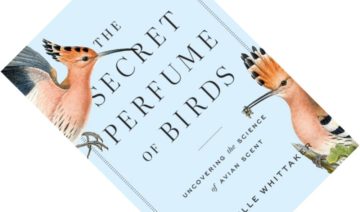 To successfully navigate their world, organisms rely on numerous senses. Birds are no exception to this; and yet, for a long time, people have been convinced that birds cannot smell. This came as a surprise to evolutionary biologist Danielle J. Whittaker. Given that smell is effectively chemoreception (the sensing of chemical gradients in your environment) and was one of the first senses to evolve, why would birds have no use for it? The Secret Perfume of Birds tells the story of 15 years spent investigating the olfactory capabilities of birds and provides an insider’s account of scientific research.
To successfully navigate their world, organisms rely on numerous senses. Birds are no exception to this; and yet, for a long time, people have been convinced that birds cannot smell. This came as a surprise to evolutionary biologist Danielle J. Whittaker. Given that smell is effectively chemoreception (the sensing of chemical gradients in your environment) and was one of the first senses to evolve, why would birds have no use for it? The Secret Perfume of Birds tells the story of 15 years spent investigating the olfactory capabilities of birds and provides an insider’s account of scientific research.
More here.
Four very useful videos on the basics of Neural Networks
Terese Svoboda’s “Dog On Fire”: An Interview
Brennie Shoup in Superstition Review:
 At turns hilariously absurd and gut-wrenchingly heartfelt, Terese Svoboda’s Dog on Fire, published by the University of Nebraska Press, defies genre. Svoboda juggles comedy, mystery, tragedy, horror—and masters them all. The book follows a recently-divorced woman grieving the mysterious and early death of her estranged brother. Her unusual circumstances lead her to move back to her small Midwestern home town, where everything and anything she does creates ripples of rumor. There, she confronts perilous Halloween parties, Jell-O inventions, guns, grave-diggers, and, of course, dogs on fire.
At turns hilariously absurd and gut-wrenchingly heartfelt, Terese Svoboda’s Dog on Fire, published by the University of Nebraska Press, defies genre. Svoboda juggles comedy, mystery, tragedy, horror—and masters them all. The book follows a recently-divorced woman grieving the mysterious and early death of her estranged brother. Her unusual circumstances lead her to move back to her small Midwestern home town, where everything and anything she does creates ripples of rumor. There, she confronts perilous Halloween parties, Jell-O inventions, guns, grave-diggers, and, of course, dogs on fire.
With rich prose more reminiscent of poetry, Svoboda’s characters burst from the page. One “harbors streaks of shyness the way bacon is streaked, between boldnesses,” while another drags “nothing out of this primordial water and [tries] to turn it inside out, into a something.” They’re as compelling and unforgettable as they are human.
More here.
Could A Machine Have An Unconscious?
Meghan O’Gieblyn at n+1:
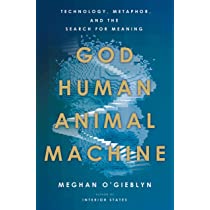 GPT-3’s most consistent limitation is “world-modeling errors.” Because it has no sensory access to the world and no programmed understanding of spatial relationships or the laws of physics, it sometimes makes mistakes no human would, like failing to correctly guess that a toaster is heavier than a pencil, or asserting that a foot has “two eyes.” Critics seize on these errors as evidence that it lacks true understanding, that its latent connections are something like shadows to a complex three-dimensional world. The models are like the prisoners in Plato’s cave, trying to approximate real-world concepts from the elusive shadow play of language.
GPT-3’s most consistent limitation is “world-modeling errors.” Because it has no sensory access to the world and no programmed understanding of spatial relationships or the laws of physics, it sometimes makes mistakes no human would, like failing to correctly guess that a toaster is heavier than a pencil, or asserting that a foot has “two eyes.” Critics seize on these errors as evidence that it lacks true understanding, that its latent connections are something like shadows to a complex three-dimensional world. The models are like the prisoners in Plato’s cave, trying to approximate real-world concepts from the elusive shadow play of language.
But it’s precisely this shadow aspect (Jung’s term for the unconscious) that makes its creative output so beautifully surreal. The model exists in an ether of pure signifiers, unhampered by the logical inhibitions that lead to so much deadweight prose.
more here.
God, Human, Animal, & Machine | Meghan O’Gieblyn
Reimagining The Shakers
Shannon Mattern at Art In America:
 Yet rather than imagining the Shakers as a romantic ideal, it might be more valuable to acknowledge the community’s contradictions and compromises. The Shakers manifested their faith through both rapturous movement and rigorous order; they embraced both simplicity and technological progress; they espoused gender equality while upholding traditional gendered labor roles; they promoted social equality while governing their own community through what some apostates and critics regarded as a rather autocratic centralized authority. They were removed from the world yet regularly did business with it. As Brother Arnold Hadd of the Sabbathday Lake Shakers—the last remaining active Shaker community—said in a 2014 interview, “We are the ultimate capitalistic communists.” On a 2020 Shaker Museum panel discussion about the sect’s continuing relevance, religious scholar Ashon Crawley explained that the Shakers performed labor as a spiritual practice in order to sustain their community, while also knowingly interacting with a world market committed to exploitation and profit. This interaction required that they willingly compromise on their vow of separation. Especially as their commercial enterprises ramped up and their population declined, Shakers occasionally hired laborers from outside the community, relying on non-Believers to produce their divinely inspired wares.
Yet rather than imagining the Shakers as a romantic ideal, it might be more valuable to acknowledge the community’s contradictions and compromises. The Shakers manifested their faith through both rapturous movement and rigorous order; they embraced both simplicity and technological progress; they espoused gender equality while upholding traditional gendered labor roles; they promoted social equality while governing their own community through what some apostates and critics regarded as a rather autocratic centralized authority. They were removed from the world yet regularly did business with it. As Brother Arnold Hadd of the Sabbathday Lake Shakers—the last remaining active Shaker community—said in a 2014 interview, “We are the ultimate capitalistic communists.” On a 2020 Shaker Museum panel discussion about the sect’s continuing relevance, religious scholar Ashon Crawley explained that the Shakers performed labor as a spiritual practice in order to sustain their community, while also knowingly interacting with a world market committed to exploitation and profit. This interaction required that they willingly compromise on their vow of separation. Especially as their commercial enterprises ramped up and their population declined, Shakers occasionally hired laborers from outside the community, relying on non-Believers to produce their divinely inspired wares.
more here.
Tuesday Poem
On Reading I Am Malala
courage is a mountain of crystal
has a breadth and grandeur
some mistake brashness for it
a loud voice, rudeness
barging past other’s boundaries
to get what they think they want
they are, of course, wrong
courage is the crocus
that has never known the brisk air
but comes into this world with an exuberance
and a beauty that says
I will die here if only I can sing my song for you
by Marc Steven Mannheimer
from, Poetry Feast
Close Encounters
Jesse Robertson in The Baffler:
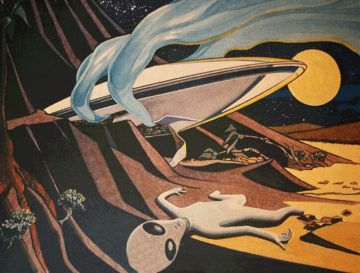 A CLASSIFIED REPORT from the Office of the Director of National Intelligence on “unidentified aerial phenomena” (UAP), or UFOs in Pentagon-speak, analyzed 366 sightings. It included videos shot by Reaper drones depicting anomalous orbs and close encounters between Navy F-18 fighter pilots and objects that defied the known laws of physics. Only half of them could be explained. Delivered to Congress on October 31, 2022, the briefing was a follow-up to the June 2021 “Preliminary Assessment: Unidentified Aerial Phenomena.” The takeaways were hazy at best, underscoring that UAP “may pose a challenge to U.S. national security” and that further investment in research and development was necessary. While these investigations seemed to mark a shift in the government’s willingness to take UFOs seriously, they were hardly the revelatory disclosure UFO enthusiasts had long pined after.
A CLASSIFIED REPORT from the Office of the Director of National Intelligence on “unidentified aerial phenomena” (UAP), or UFOs in Pentagon-speak, analyzed 366 sightings. It included videos shot by Reaper drones depicting anomalous orbs and close encounters between Navy F-18 fighter pilots and objects that defied the known laws of physics. Only half of them could be explained. Delivered to Congress on October 31, 2022, the briefing was a follow-up to the June 2021 “Preliminary Assessment: Unidentified Aerial Phenomena.” The takeaways were hazy at best, underscoring that UAP “may pose a challenge to U.S. national security” and that further investment in research and development was necessary. While these investigations seemed to mark a shift in the government’s willingness to take UFOs seriously, they were hardly the revelatory disclosure UFO enthusiasts had long pined after.
More here.
michael jackson billie jean live first time moonwalk
(Note: Throughout February, at least one post will be dedicated to Black History Month. The theme for 2023 is Black Resistance. Please send us anything you think is relevant for inclusion)
Sunday, February 26, 2023
Will U.S.-Israel Policies Ever Change?
Jeremy Pressman in the Boston Review:
 In the 1970s and ’80s, many American Jews backed pro-Israel interest groups in Washington, D.C., which quickly gained resources and political influence. By the late 1990s most Jewish leaders not only embraced Israel for the country’s sake but also believed that supporting Israel was key to the survival of U.S. Jews—the largest diaspora Jewish community. Since 1967 Israel’s centrality to Jewish identity has only deepened. The most obvious manifestation is the Birthright program, which was launched in 1999 and has since brought more than 800,000 young American Jews on entirely free ten-day or two-week trips to Israel, with many of its participants visiting the country for the first time. This year the State of Israel celebrates its seventy-fifth anniversary, marking less than a century of existence during which the country has shifted profoundly. Israel is now the most powerful state in the Middle East. Not only is it independent, wealthy, and nuclear-armed, it is also embraced by many Jewish cultural, political, and religious organizations around the world.
In the 1970s and ’80s, many American Jews backed pro-Israel interest groups in Washington, D.C., which quickly gained resources and political influence. By the late 1990s most Jewish leaders not only embraced Israel for the country’s sake but also believed that supporting Israel was key to the survival of U.S. Jews—the largest diaspora Jewish community. Since 1967 Israel’s centrality to Jewish identity has only deepened. The most obvious manifestation is the Birthright program, which was launched in 1999 and has since brought more than 800,000 young American Jews on entirely free ten-day or two-week trips to Israel, with many of its participants visiting the country for the first time. This year the State of Israel celebrates its seventy-fifth anniversary, marking less than a century of existence during which the country has shifted profoundly. Israel is now the most powerful state in the Middle East. Not only is it independent, wealthy, and nuclear-armed, it is also embraced by many Jewish cultural, political, and religious organizations around the world.
Alterman’s book then comes at an opportune time, tracking “the debate over Israel in the United States” and offering a close study of ethnoreligious identity, diaspora relations, and foreign policy as the landscape of Israeli support has grown increasingly complex. The book also teases out four important consequences of American Jews centering the Israeli state in Jewish identity.
More here.
Gene Expression in Neurons Solves a Brain Evolution Puzzle
Allison Whitten in Quanta:
 The neocortex stands out as a stunning achievement of biological evolution. All mammals have this swath of tissue covering their brain, and the six layers of densely packed neurons within it handle the sophisticated computations and associations that produce cognitive prowess. Since no animals other than mammals have a neocortex, scientists have wondered how such a complex brain region evolved.
The neocortex stands out as a stunning achievement of biological evolution. All mammals have this swath of tissue covering their brain, and the six layers of densely packed neurons within it handle the sophisticated computations and associations that produce cognitive prowess. Since no animals other than mammals have a neocortex, scientists have wondered how such a complex brain region evolved.
The brains of reptiles seemed to offer a clue. Not only are reptiles the closest living relatives of mammals, but their brains have a three-layered structure called a dorsal ventricular ridge, or DVR, with functional similarities to the neocortex. For more than 50 years, some evolutionary neuroscientists have argued that the neocortex and the DVR were both derived from a more primitive feature in an ancestor shared by mammals and reptiles.
Now, however, by analyzing molecular details invisible to the human eye, scientists have refuted that view.
More here.
Racism Rebranded
Kenan Malik in Pandaemonium:
 We live in an age in which in most societies there is a moral abhorrence of racism, albeit that in most, bigotry and discrimination still disfigure the lives of many. We also live in an age saturated with identitarian thinking and obsessed with placing people into racial boxes. The more we despise racial thinking, the more we seem to cling to it.
We live in an age in which in most societies there is a moral abhorrence of racism, albeit that in most, bigotry and discrimination still disfigure the lives of many. We also live in an age saturated with identitarian thinking and obsessed with placing people into racial boxes. The more we despise racial thinking, the more we seem to cling to it.
This paradox is at the heart of my new book. Not So Black and White is a retelling of the history both of the idea of race and of the struggles to confront racism and to transcend racial categorisation, a retelling that challenges many of the ways in which we think both of race and of antiracism.
Most people assume that racism emerges when members of one race begin discriminating against members of another. In fact, the opposite is the case: intellectuals and elites began dividing the world into distinct races to explain and justify the differential treatment of certain peoples. The ancestors of today’s African Americans were not enslaved because they were black. They were deemed to be racially distinct, as black people, to justify their enslavement.
More here.
Sean Carroll’s Mindscape Podcast: Molly Crockett on the Psychology of Morality
Sean Carroll in Preposterous Universe:
 Most of us strive to be good, moral people. When we are doing that striving, what is happening in our brains? Some of our moral inclinations seem pretty automatic and subconscious. Other times we have to sit down and deploy our full cognitive faculties to reason through a tricky moral dilemma. I talk with psychologist Molly Crockett about where our moral intuitions come from, how they can sometimes serve as cover for bad behaviors, and how morality shapes our self-image.
Most of us strive to be good, moral people. When we are doing that striving, what is happening in our brains? Some of our moral inclinations seem pretty automatic and subconscious. Other times we have to sit down and deploy our full cognitive faculties to reason through a tricky moral dilemma. I talk with psychologist Molly Crockett about where our moral intuitions come from, how they can sometimes serve as cover for bad behaviors, and how morality shapes our self-image.
More here.
Where on Earth is paradise?
Rory Sullivan in Prospect Magazine:
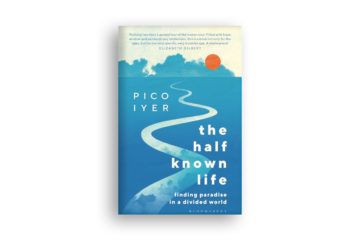 After 50 years of globetrotting, the celebrated travel writer Pico Iyer asks himself whether it is possible to find paradise in a violent, fragmented world. In pursuit of an answer, he stitches together a selection of his trips to beautiful, troubled spots, including Jerusalem and Kashmir, for his latest book. At first, his enquiry seems too wide and too vague. Iyer’s disparate writings on Iran, Israel and Australia only scratch the surface of the problems in each country, while “paradise” itself is defined too broadly. The author’s visit to Broome, a remote town hundreds of miles from Perth, is especially lacking in depth: interesting snippets about, for example, the effect of the 19th-century pearl boom on its Aboriginal community, do not receive further investigation.
After 50 years of globetrotting, the celebrated travel writer Pico Iyer asks himself whether it is possible to find paradise in a violent, fragmented world. In pursuit of an answer, he stitches together a selection of his trips to beautiful, troubled spots, including Jerusalem and Kashmir, for his latest book. At first, his enquiry seems too wide and too vague. Iyer’s disparate writings on Iran, Israel and Australia only scratch the surface of the problems in each country, while “paradise” itself is defined too broadly. The author’s visit to Broome, a remote town hundreds of miles from Perth, is especially lacking in depth: interesting snippets about, for example, the effect of the 19th-century pearl boom on its Aboriginal community, do not receive further investigation.
However, the book improves immensely as it progresses through stops in Sri Lanka, Japan and India—and as Iyer’s conversational skills become more apparent. His exchange with the caretaker of a Sri Lankan colonial cemetery is touching, as is his visit to the Varanasi home of a 78-year-old Indian professor who starts reciting Paradise Lost from memory. Striking images also drift into the text: the roofs of Japanese temples resemble “the prows of seagoing vessels about to sail off into the mist”.
The book’s search for paradise comes to take on an internalised dimension, beyond the aesthetic and religious. To quote Milton, the quest is to find “a Paradise within thee, happier far”. For Iyer, this means coming to terms with uncertainty in a world that “seems always to simmer in a state of answerlessness”.
More here.
Barack Obama’s 2008 speech on race and politics
(Note: Throughout February, at least one post will be dedicated to Black History Month. The theme for 2023 is Black Resistance. Please send us anything you think is relevant for inclusion)
